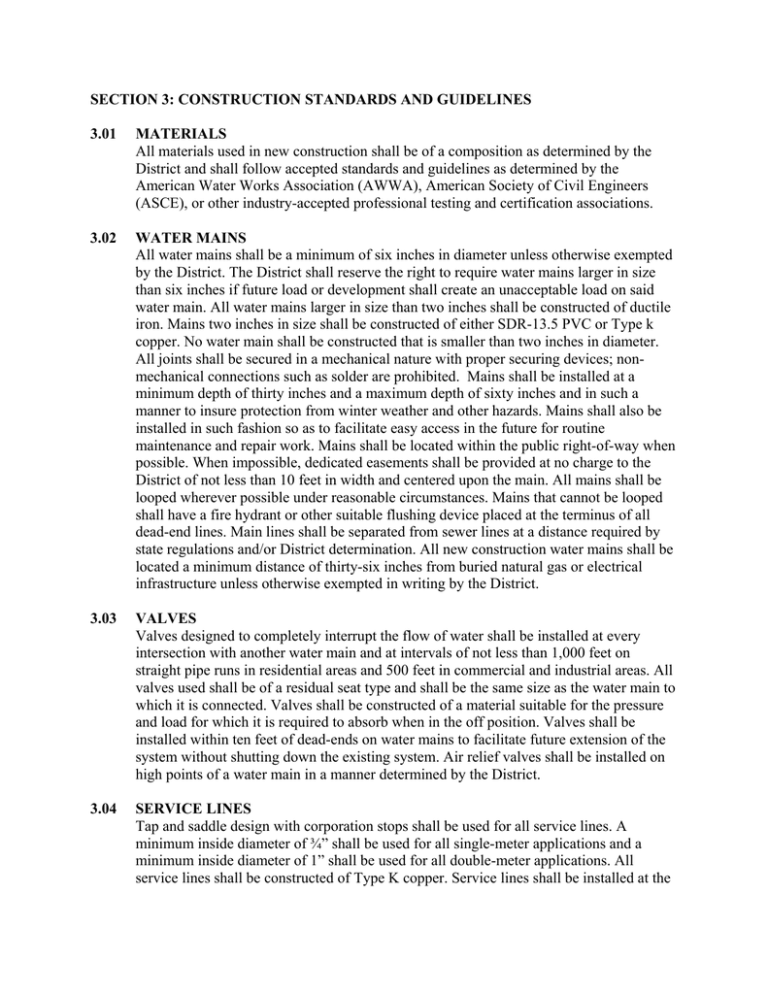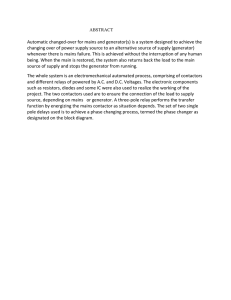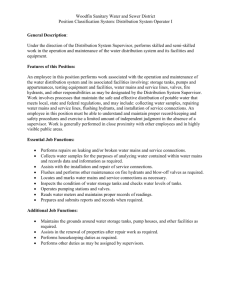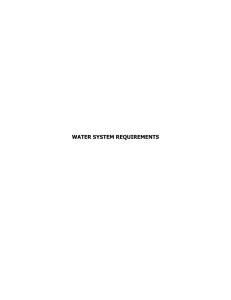Construction Standards and Specifications
advertisement

SECTION 3: CONSTRUCTION STANDARDS AND GUIDELINES 3.01 MATERIALS All materials used in new construction shall be of a composition as determined by the District and shall follow accepted standards and guidelines as determined by the American Water Works Association (AWWA), American Society of Civil Engineers (ASCE), or other industry-accepted professional testing and certification associations. 3.02 WATER MAINS All water mains shall be a minimum of six inches in diameter unless otherwise exempted by the District. The District shall reserve the right to require water mains larger in size than six inches if future load or development shall create an unacceptable load on said water main. All water mains larger in size than two inches shall be constructed of ductile iron. Mains two inches in size shall be constructed of either SDR-13.5 PVC or Type k copper. No water main shall be constructed that is smaller than two inches in diameter. All joints shall be secured in a mechanical nature with proper securing devices; nonmechanical connections such as solder are prohibited. Mains shall be installed at a minimum depth of thirty inches and a maximum depth of sixty inches and in such a manner to insure protection from winter weather and other hazards. Mains shall also be installed in such fashion so as to facilitate easy access in the future for routine maintenance and repair work. Mains shall be located within the public right-of-way when possible. When impossible, dedicated easements shall be provided at no charge to the District of not less than 10 feet in width and centered upon the main. All mains shall be looped wherever possible under reasonable circumstances. Mains that cannot be looped shall have a fire hydrant or other suitable flushing device placed at the terminus of all dead-end lines. Main lines shall be separated from sewer lines at a distance required by state regulations and/or District determination. All new construction water mains shall be located a minimum distance of thirty-six inches from buried natural gas or electrical infrastructure unless otherwise exempted in writing by the District. 3.03 VALVES Valves designed to completely interrupt the flow of water shall be installed at every intersection with another water main and at intervals of not less than 1,000 feet on straight pipe runs in residential areas and 500 feet in commercial and industrial areas. All valves used shall be of a residual seat type and shall be the same size as the water main to which it is connected. Valves shall be constructed of a material suitable for the pressure and load for which it is required to absorb when in the off position. Valves shall be installed within ten feet of dead-ends on water mains to facilitate future extension of the system without shutting down the existing system. Air relief valves shall be installed on high points of a water main in a manner determined by the District. 3.04 SERVICE LINES Tap and saddle design with corporation stops shall be used for all service lines. A minimum inside diameter of ¾” shall be used for all single-meter applications and a minimum inside diameter of 1” shall be used for all double-meter applications. All service lines shall be constructed of Type K copper. Service lines shall be installed at the proper minimum depth and in such a manner so as to insure protection from winter weather and other hazards. Service lines shall be designed so that the customer’s connection to the meter shall not cross any road, railroad, body of water, or other impediment to the customer’s future repair or replacement of their service line. 3.05 FIRE PROTECTION SERVICE LINES Whenever fire protection lines are desired by the applicant or required by local and/or state regulation, plans shall be submitted and approved by the District prior to connection with the District water supply system. Sprinklers, fire lines, and the like shall be constructed using accepted AWWA standards. All fire protection service lines shall be equipped with a suitable backflow prevention device to prevent cross-contamination of the District water supply. Water meters designed to detect the flow of water through a fire protection line shall be installed on all fire protection service lines. 3.06 FIRE HYDRANTS Hydrants shall be placed at a minimum distance of 500 feet on a water main of 6” or greater in size; any deviation from this requirement shall require a written exemption from the District. Any hydrant placed in an area where two streets form an intersection shall be located at a minimum distance of twenty feet from the corner of the intersection. All hydrants shall be installed with proper bracing and restraining devices and shall be equipped with a suitable residual seat valve to facilitate future repairs and maintenance. Hydrants shall be of a brand and model as prescribed by the District unless otherwise waived in writing. Hydrants shall be installed so that the traffic break-away portion of the hydrant is located at ground level in order to perform properly in the event of an accident. 3.07 METERS AND METER BOXES All meters and meter boxes shall be of a brand and model as prescribed by the District unless otherwise waived in writing. A minimum meter box width of 18” at its widest point and depth of 24” shall be used. Meter boxes shall be located out of the flow of traffic where practical. When a box must be located within the flow of traffic, such as a road or driveway, the meter box and lid shall be of a suitable construction so as to withstand anticipated vehicular loads. Under no circumstances shall a meter box be located in such a manner so as to cause unnecessary danger to District personnel attempting to service, read, or adjust said meter or meter box. Meter boxes shall be located at the front edge of a property closest to that property’s street access, when practical. Meter boxes shall be located so as to provide each customer unimpeded access to the meter box without crossing property lines, utility easements, or other obstacles to future repair and maintenance. Meters shall be installed in a yoke-type assembly that contains a cut-off and backflow prevention valve and shall be installed in such a manner so that the meter face deviates from a strictly upright facing by no more than 15 degrees. 3.08 BEDDING AND BACKFILL Bedding and backfill shall be of a material and nature as specified by the manufacturer of each water main. Bedding and backfill shall be compacted as required by the manufacturer of each water main. 3.09 SLEEVES, COUPLINGS, FITTINGS All sleeves, couplings, and other fittings shall be constructed and designed of a suitable material and manner so as to sufficiently handle the pressure and load placed upon it. All sleeves, couplings, and fittings shall be approved by the District. 3.10 PUMPING STATIONS Pumping stations shall not be approved by the District except in circumstances whereupon service cannot be satisfactorily rendered but with a pumping station. All proposed pumping stations must be approved in writing by the District. All pumps and related appurtenances must be of a manufacturer and construction acceptable to the District, who shall have the final say on all proposed installations. No pumping station shall be installed without an acceptable duplicate reserve pump and an acceptable emergency generator system located on-site. Pumping stations shall require the payment of an impact fee to be calculated by the District and certified to the developer, payment of which must be made in full before service is provided to the pumping station. The criteria for generation of the impact fee shall be based on twenty years of maintenance and operational costs, including inflation, as well as the costs for one-time replacement of the main pump, reserve pump, control valve(s), and emergency generator system. An inflation multiplier of 1.81%, based on a three percent annual compounded cost factor, shall be applied to operation, maintenance and replacement costs. 3.11 STORAGE TANKS Storage tanks shall be constructed in a manner and of a material approved by the District. Installation of storage tank(s) shall require the payment of an impact fee to be calculated by the District and certified to the developer, payment of which must be made in full before service is provided to the storage tank. The criteria for generation of the impact fee shall be based on twenty years of maintenance and operational costs, including inflation, as well as the costs for one-time replacement of gauges, control valves, and other appurtenances required for proper tank operation. An inflation multiplier of 1.81%, based on a three percent annual compounded cost factor, shall be applied to operation, maintenance and replacement costs. 3.12 TESTING Bacterial and chlorine testing shall be performed on all new water mains prior to being placed in operation with the District’s system. All testing and results shall be performed by a certified laboratory and results of testing shall be provided to the District. Prior to being placed in operation with the District’s system, all water mains shall be pressure tested to confirm the absence of leaks within the system. All valves, hydrants, and other fixtures shall be tested to confirm their proper operation. 3.13 WARRANTY OF SERVICE All water mains, valves, pumping stations, storage tanks, service lines, meter boxes, and other fixtures or construction not provided by the District shall be warranted by the applicant for new construction for a period of one year from the in-service date provided by the District. 3.14 CONTINGENCIES All other situations not covered by these Construction Standards and Guidelines shall be resolved at the sole discretion of the District Director and/or Board of Trustees.



